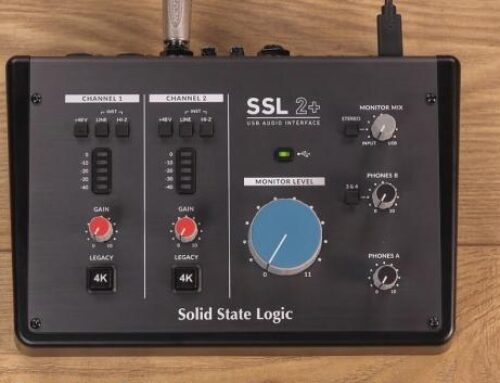7 Rules of Recording the Singing Guitarist
by Jessica Brandon
The challenge of recording a vocalist/guitarist singing guitarist is that you are, in effect, trying to capture two sources at the same time and in close quarters. The microphone choice and placement that gives you the perfect guitar sound might completely foul up the vocal sound, and vice versa.
Plus, you would think recording an acoustic guitar would be easy. And yet, 9 times out of 10 when I hear a mix from a home studio recording, the acoustic track sounds thin, harsh, muddy, and just downright disappointing. A bad acoustic guitar track can bring the quality of the entire mix down considerably.
Rule #1 – Acoustic and Any Noise to deal with
Are you’re dealing with a relatively quiet source, or do you have noise pollution from whirring air conditioning units, computer fans, central heating pipes, buzzing fluorescent tubes, traffic outside and so on? This can be murder, so be sure to vet both your recording setup and recording environment appropriately.
Rule #2 – Do Not Record With A DI
Direct boxes are often referred to as “DI” boxes. This stands for “Direct Injection” as their main purpose is to convert unbalanced and/or high impedance instrument signals into a format suitable for direct connection to a mixing console’s mic input – without the use of a microphone.
The rule is never record your acoustic guitar through the internal pickup into a DI. Why? This is because it sounds bad. I have seen acoustic electric guitars being plugged into DIs on stage at church and other venues but in a recording situation, the recording turns out sounding horrible and unnatural. No one ever listens to an acoustic guitar with their head inside the sound hole. So why do we try to record that sound?
Instead people hear acoustics from outside the sound hole. We like to hear the strumming and the entire body and resonance of the guitar (more on that below).
So please – trust me on this. If you are currently recording your acoustics through the pickup and through a DI, stop today. Use a microphone instead. It will sound infinitely better.
Rule #3 – How to Mic the Vocals & Guitar
Try to use separate close mics for the vocals and the guitar, to achieve the most pleasing sound possible on both, and to gain, if possible, a useful degree of separation between the two, which will allow independent treatment at the mix: different reverbs, level rides, EQ and so on.
A friend of mine recorded his vocals on a Shure SM57 microphone with a vocal filter a separate Shure SM57 microphone on his acoustic steel string guitar. He liked the results of his recordings on his tight budget. To my ears, though, while the vocal sound from the SM7 is perfectly usable, it doesn’t come close to that of the Neumann, and personally I would choose the better vocal sound over increased isolation in this case. (If you want that level of isolation with the clarity of a condenser mic, you could try one of the modern stage condenser designs such as the Neumann KMS105, Sennheiser e965, AKG C5 or Shure Beta 87a.)
Another option is to treat voice and guitar as a single sound source (which, after all, is what any listeners in the room will hear) and use relatively distant mic techniques to capture it all in one go.
Rule #4 – Minimizing Vocal Spill
You will need to know how to capture a good guitar sound that is relatively free from vocal spill. The challenge in this situation is to capture a nice guitar sound while minimizing vocal spill onto the guitar mics. Without the added complication of vocals to think about, the most common point to focus on when close-miking a guitar is the area where the neck joins the body.
If that didn’t yield the required sound, or we wanted to add a second microphone for a stereo guitar recording, most of us would probably next shift our attention to the area around the bridge, perhaps just behind or below it.
Rule #5 – Miking The Voice
Choosing a microphone and mic position for the top half of your singing guitarist is, similarly, about balancing the twin priorities of achieving a good vocal sound and rejecting guitar spill. And, once again, ‘normal’ vocal miking techniques are often perfectly successful in this application, as long as you don’t go too far away. If you’re using a conventional large-diaphragm condenser microphone (such as Audio-Technica AT2035), and you place it as close to the mouth as you’re comfortable with — personally I’d want it at least four inches or so away — then as long as your singer has a reasonably strong voice and doesn’t move about too much, chances are you’ll get a healthy vocal level without too much guitar spill. I usually try to avoid pop shields, as I feel they color the sound, but if your microphone is right in front of the singer’s mouth, you will need something to reduce popping and protect the mic diaphragm from moisture.
Rule #6 – Mixing A Singing Guitarist
When you’re just recording solo guitar and vocals, the options available for fixing things at the mix are minimal. If you didn’t get it right at the recording stage, chances are it will never be absolutely right, although there are certainly rescue missions you can attempt. For example, if there are audible phase problems between the vocal and guitar mic, and you can visually identify vocal events within the guitar track, ‘slipping’ the vocal part by a few tens of samples for better alignment can sometimes help. If you use one of the techniques that aims for a high level of separation, you might also find that you can comp the odd dodgy vocal word or phrase in from a different take without it being too obvious.
In general, compressing either the vocal or guitar mics will tend to bring up the level of any spill contained therein, so don’t be too heavy-handed with the threshold control. As this sort of music can often be quite delicate in any case, I much prefer to keep compression to a minimum, and use automation to draw in level changes. Achieving the right balance between guitar and vocal can be surprisingly difficult, so don’t be afraid to make fairly radical moves on occasion. Also, don’t be too aggressive in muting the vocal mic where the singer isn’t singing, because if there is guitar spill on the vocal track, the guitar sound will suddenly change as soon as the vocal fader is raised.
One of the major advantages of gaining some separation between vocal and guitar mics is that you can use two different reverbs, or at least different amounts of reverb, on the two signals. My own preference for vocals is usually something plate-ish, with plenty of pre-delay, and perhaps a touch of slapback echo. On guitars, by contrast, a much more natural reverb is often the order of the day — perhaps something involving mainly early reflections, just to add a bit of life and zing to proceedings. Separation will, of course, also allow you to equalise the two signals independently if need be, although, again, you need to be aware that adding a large high-frequency boost to the vocals will make the guitar spill much more obvious. If you’re forced to use the output from a pickup as your main source of guitar sound, you might need to get much more radical with EQ or even multi-band compression; both piezo and magnetic pickups tend to put out too much mid-range, which will need to be reined in if you are to achieve a natural sound.
Rule #7 – Determine what is it you wish to accomplish
This is probably the most important rule is to ask yourself what exactly it is you really wish to accomplish, how you really want to sound like? Can you envision the sound of your vocals and guitar?
The seven rules above, however, are applicable EVERY time you sit down to record a singing guitarist and they will serve you well. Follow them and your recordings will improve. The rest is open to your tastes.
Do you agree or disagree with these 7 rules? If you could add a eighth rule what would it be?
For more information on the 15th Annual IAMA (International Acoustic Music Awards), go to: http://www.inacoustic.com




